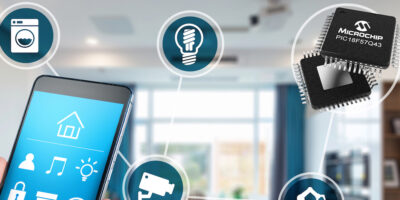Microchip offloads tasks to hardware to accelerate design
More Core Independent Peripherals are combined in the latest PIC microcontroller family from Microchip. The PIC18-Q43 family moves software tasks to hardware for a faster system response. Microchip has also introduced a development tool ecosystem for real-time control and connectivity design projects.
Microchip’s PIC18-Q43 family’s peripherals are configurable and to allow near-zero latency sharing of data, logic inputs or analogue signals without additional code for improved system response. The PIC microcontroller family can be used to create custom hardware-based functions in real-time control and connected applications, including home appliances, security systems, motor and industrial control, lighting and the IoT. According to Microchip, the PIC18-Q43 family helps reduce board space, bill of materials (BoM), overall costs and time to market.
Core Independent Peripherals (CIPs) are designed with additional capabilities to handle a variety of tasks without the need for intervention from the central processing unit (CPU). CIPs include timers, simplified pulse width modulation (PWM) output, configurable logic cells (CLCs), ADCs with computation (ADCC) and multiple serial communications, designed for developers to customise a specific design configuration. The CLC provides programmable logic that operates outside the speed limitations of software execution, so that customers can tailor functions such as waveform generation or timing measurements. CLCs connect on-chip peripherals for hardware customisation and allow developers to customise a device with core-independent communication interfaces, including UART, SPI and I2C. Multiple DMA channels and interrupt management have been added to accelerate real-time control with simplified software loops.
The PIC18-Q43 family operates up to 5.0V which increases noise immunity and enables customers to interface to a wide range of sensors.
Microchip’s development tool suite has been created to offer users the means to quickly and easily generate application code and customise combinations of CIPs in a graphical user interface (GUI) environment.
The PIC18-Q43 family is supported by Microchip’s MPLAB X IDE and MPLAB Xpress IDE development environments, and MPLAB Code Configurator (MCC) a free software plug-in that provides a graphical interface to configure peripherals and functions specific to an application. There is also the PIC18F57Q43 Curiosity Nano development board which has programming and debugging capabilities.




